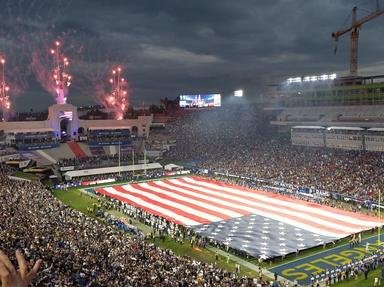Quiz Answer Key and Fun Facts
1. Georgia Tech defeated California in the 1929 Rose Bowl game by a score of 8-7. A key play in that game occurred when a California football player recovered a fumble, got turned around, and ran the wrong way towards his own end zone. What was the name of that player?
2. In a regular season NFL game in 1969, this Minnesota Viking defensive lineman picked up a fumble and ran the wrong way, leading to a safety. Who was this unfortunate player?
3. One of the most dramatic moments in baseball occurs when the home team rallies from a deficit to win a game in their last at bat. One of the most famous occurred in the final playoff game between hated rivals, the New York Giants and the Brooklyn Dodgers, in 1951 when Bobby Thompson hit a game winning home run. Who was the relief pitcher for the Dodgers who threw that fateful pitch?
4. A walk-off home run during the 1986 playoffs occurred when Donnie Moore had a one run lead in the top of the ninth inning and allowed a two run home run to Dave Henderson of the Boston Red Sox. What team (trying to reach the World Series for the first time) did Moore pitch for?
5. Probably the most dramatic World Series ending occurred in 1960 when Bill Mazeroski of the Pittsburgh Pirates hit a game ending home run in the bottom of the ninth of the seventh game for a 10-9 victory over the New York Yankees. Which Yankee pitcher made that pitch?
6. The winner in the final National League game of the 1908 season between the Chicago Cubs and New York Giants would be the league representative in the World Series. With the score tied 1-1 in the bottom of the ninth inning the Giants had runners on first and third base with two outs. The ensuing play was a "base hit" to left field; however the runner on first was ruled out because he never kept running to second base. Who was this player who became synonymous with bonehead plays?
7. English soccer fans had great hope that the "Golden Generation" of players could win the 1998 World Cup. Their hopes were dashed in the knockout stage with a loss to Argentina. With the score tied 2-2 in the first half a red card foul was called against an England midfielder. Who was this charismatic player?
8. Italy and Brazil played a scoreless game in the 1994 World Cup finale. In the penalty shoot-out an Italian player known as the "Divine Ponytail" missed the final Italian penalty kick, hitting it over the crossbar. What was his name? (Hint, the three wrong answers give the birth names of gentlemen better known by other names)
9. In 1990 the University of Michigan assembled a talented young basketball squad that was labeled the "Fab Five" and thought to be favorite to win several NCAA championships. In the 1993 championship game against North Carolina the star of the squad drew a technical foul in the closing seconds for calling a timeout when his team had none left. Who was the player?
10. This Dallas Cowboys defensive lineman had not one, but two, infamous plays in 1993. In Superbowl 27 he was racing towards a record touchdown return when he started to celebrate prematurely and lost the football. Later that same year he made another bonehead play when he touched a last ditch field goal attempt that had been blocked to allow the opposition another opportunity. Who was he?
Source: Author
SixShutouts66
This quiz was reviewed by FunTrivia editor
gtho4 before going online.
Any errors found in FunTrivia content are routinely corrected through our feedback system.
